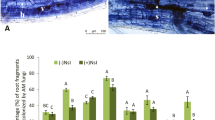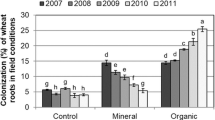Abstract
Most plant species naturally associate with arbuscular mycorrhizal fungi (AMF), which are known to promote crop nutrition and health in agroecosystems. However, information on how mycorrhizal associations affect plant biotic interactions that occur aboveground with foliar herbivores is limited and needs to be further addressed for the development of pest management strategies. With the objective to examine the influence of maize mycorrhizas on foliar herbivory caused by larvae of Spodoptera frugiperda, a serious pest in maize agroecosystems, we performed a fully factorial greenhouse pot experiment with three factors: Maize genotype (Puma and Milpal H318), AMF (with and without AMF, and without AMF with mineral P) and Insect herbivory (with and without S. frugiperda). Main results showed that inoculation with AMF improved plant growth and foliar P concentration, which coincided with increased foliar damage from herbivory and higher biomass of S. frugiperda larvae. A significant positive correlation between shoot P concentration and larval biomass was also observed. Finally, foliar herbivory by S. frugiperda slightly increased and decreased AMF root colonization in Puma and H318, respectively. In conclusion, our results show that maize plant benefits from AMF in terms of promotion of growth and nutrition, and may also increase the damage caused from insects by improving the food quality of maize leaves for larval growth, which seems to be linked to increased P uptake by the maize mycorrhizal association.




Similar content being viewed by others
References
Altieri M, Nicholls C (2004) Biodiversity and pest management in agroecosystems. CRC Press, Boca Raton
Alvarado-Herrejón M, Larsen J, Gavito ME, Jaramillo-López PF, Vestberg M, Martínez-Trujillo M, Carreón-Abud Y (2019) Relation between arbuscular mycorrhizal fungi, root-lesion nematodes and soil characteristics in maize agroecosystems. Appl Soil Ecol 135:1–8
Barto EK, Rillig MC (2010) Does herbivory really suppress mycorrhiza? A meta-analysis. J Ecol 98:745–753
Bennetzen JL, Hake SC (eds) (2009) Handbook of maize: genetics and genomics. Springer Science & Business Media, Berlin
Bernaola L, Cosme M, Schneider RW, Stout M (2018) Belowground inoculation with arbuscular mycorrhizal fungi increases local and systemic susceptibility of rice plants to different pest organisms. Front Plant Sci 9:747
Bremner JM (1996) Nitrogen-total. In: Sparks DL (ed) Methods of soil analysis, part 3. Soil Science Society of America, Madison, pp 1085–1121
Chishaki N, Horiguchi T (1997) Responses of secondary metabolism in plants to nutrient deficiency. Soil Sci Plant Nutr 43:987–991
Clancy KM, King R (1993) Defining the western spruce budworm’s nutritional niche with response surface methodology. Ecology 74:442–454
Deng Y, Feng G, Chen X, Zou C (2017) Arbuscular mycorrhizal fungal colonization is considerable at optimal Olsen-P levels for maximized yields in an intensive wheat–maize cropping system. Field Crop Res 209:1–9
Domínguez CA, Dirzo R (1995) Rainfall and flowering synchrony in a tropical shrub: variable selection on the flowering time of Erythroxylum havanense. Evol Ecol 9:204–216
Estiarte M, Filella I, Serra J, Penuelas J (1994) Effects of nutrient and water stress on leaf phenolic content of peppers and susceptibility to generalist herbivore Helicoverpa armigera (Hubner). Oecol 99:387–391
Fortier E, Desjardins Y, Tremblay N, Bélec C, Côté M (2006) Influence of irrigation and nitrogen fertilization on broccoli polyphenolics concentration. In International Symposium on Vegetable Safety and Human Health 856, pp 55–62
Gange AC (2007) Insect mycorrhizal interactions: patterns, processes and consequences. In: Ohgushi T et al (eds) Ecological communities: plant mediation in indirect interaction webs. Cambridge University Press, Cambridge, pp 124–143
Gange AC, Bower E, Brown VK (2002) Differential effects of insect herbivory on arbuscular mycorrhizal colonization. Oecol 131:103–112
García-Rodríguez Y, Bravo-Monzón A, Martínez-Díaz Y, Torres-Gurrola G, Espinosa-García FJ (2012) Variación Fitoquímica Defensiva en Ecosistemas Terrestres. In: Rojas JC, Malo EA (eds) Temas Selectos en Ecología Química de Insectos. El Colegio de la Frontera sur, Lerma Campeche, pp 217–252 446 p
Garrido E, Bennett AE, Fornoni J, Strauss SY (2010) Variation in arbuscular mycorrhizal fungi colonization modifies the expression of tolerance to above-ground defoliation. J Ecol 98:43–49
Gavito ME, Miller MH (1998) Changes in mycorrhiza development in maize induced by crop management practices. Plant Soil 198:185–192
Gehring C, Bennett A (2009) Mycorrhizal fungal–plant–insect interactions: the importance of a community approach. Environ Entomol 38:93–102
Gershenzon J (1984) Changes in the levels of plant secondary metabolites under water and nutrient stress. In: Phytochemical adaptations to stress. Springer, Boston, pp 273–320
Gianinazzi S, Gollotte A, Binet MN, van Tuinen D, Redecker D, Wipf D (2010) Agroecology: the key role of arbuscular mycorrhizas in ecosystem services. Mycorrhiza 20:519–530
Giovannetti M, Mosse (1980) An evaluation of techniques for measuring vesicular arbuscular mycorrhizal infection in roots. New Phytol 84:489–500
Goverde M, van der Heijden M, Wiemken A, Sanders I, Erhardt A (2000) Arbuscular mycorrhizal fungi influence life history traits of a lepidopteran herbivore. Oecol 125:362–369
Heinen R, Biere A, Harvey JA, Bezemer M (2018) Effects of soil organisms on aboveground plant–insect interactions in the field: patterns, mechanisms and the role of methodology. Front Ecol Evol 6:106
Hoffmann D, Vierheilig H, Peneder S, Schausberger P (2011) Mycorrhiza modulates aboveground tri-trophic interactions to the fitness benefit of its host plant. Ecol Entomol 36:574–581
Huberty AF, Denno RF (2006) Consequences of nitrogen and phosphorus limitation for the performance of two planthoppers with divergent life-history strategies. Oecol 149:444–455
Janssen JAM (1994) Impact of the mineral composition and water content of excised maize leaf sections on fitness of the African armyworm, Spodoptera exempta (Lepidoptera: Noctuidae). Bull Entomol Res 84:233–245
Koricheva J, Gange AC, Jones T (2009) Effects of mycorrhizal fungi on insect herbivores: a meta-analysis. Ecol 90:2088–2097
Kormanik PP, McGraw AC (1982) Quantification of vesicular arbuscular mycorrhiza in plant roots. In: Schenck NC (ed) Methods and principles of mycorrhizal research. American Phytopathological Society, St Paul, pp 37–45
Kumar A, Verma JK (2018) Does plant–microbe interaction confer stress tolerance in plants?: a review. Microbiol Res 207:41–52
López-Carmona DA (2013) Respuesta de micorrizas de maíz (Zea mays) a un gradiente de estrés hídrico y fertilización mineral. MSc thesis. Universidad Nacional Autónoma de México. 77 p
López-Carmona DA, Alarcón A, Martínez-Romero E, Peña-Cabriales JJ, Larsen J (2019) Maize plant growth response to whole rhizosphere microbial communities in different mineral N and P fertilization scenarios. Rhizosphere 9:38–46
Machado RA, Ferrieri AP, Robert CA, Glauser G, Kallenbach M, Baldwin IT, Erb M (2013) Leaf-herbivore attack reduces carbon reserves and regrowth from the roots via jasmonate and auxin signaling. New Phytol 200:1234–1246
Mattson WJ Jr (1980) Herbivory in relation to plant nitrogen content. Ann Rev Ecol Syst 11:119–161
Mauch-Mani B, Baccelli I, Luna E, Flors V (2017) Defense priming: an adaptive part of induced resistance. Annu Rev Plant Biol 68:485–512
Médiène S, Valantin-Morison M, Sarthou JP, De Tourdonnet S, Gosme M, Bertrand M, Pelosi C (2011) Agroecosystem management and biotic interactions: a review. Agron Sustain Dev 31:491–514
Murphy J, Riley JP (1962) A modified single solution method for the determination of phosphate in natural waters. Anal Chim Acta 27:31–36
Murrell EG, Ray S, Lemmon ME, Luthe DS, Kaye JP (2019) Cover crop species affect mycorrhizae-mediated nutrient uptake and pest resistance in maize. Renew Agr food Syst:1–8
Núñez-Farfán J, Fornoni J, Valverde PL (2007) The evolution of resistance and tolerance to herbivores. Annu Rev Ecol Evol Syst 38:541–566
Pedigo LP, Rice M (2009) Entomology and pest management. Pearson, London
Perkins MC, Woods HA, Harrison JF, Elser JJ (2004) Dietary phosphorus affects the growth of larval Manduca sexta. Arch Insect Biochem Physiol 55:153–168
Peterson RKD, Varella AC, Higley LG (2017) Tolerance: the forgotten child of plant resistance. PeerJ. https://doi.org/10.7717/peerj.3934
Poitout S, Bues R (1974) Elevage de chenilles de vingt-huit espèces de Lépidoptères Noctuidae et de deux espèces d'Arctiidae sur milieu artificiel simple. Particularités de l'élevage selon les espèces In Annales de zoologie: Ecologie animale
Pozo MJ, Azcón AC (2007) Unraveling mycorrhiza-induced resistance. Curr Opin Plant Biol 10:393–398
Ramírez Gómez M, Rodríguez A (2012) Mecanismos de defensa y respuestas de las plantas en la interacción micorrícica: una revisión. Rev Colomb Biotecnol 14:271–284
Ryan MH, Graham JH (2018) Little evidence that farmers should consider abundance or diversity of arbuscular mycorrhizal fungi when managing crops. New Phytol 220:1092–1107
Sarabia M, Cornejo P, Azcón R, Carreón-Abud Y, Larsen J (2017) Mineral phosphorus fertilization modulates interactions between maize, rhizosphere yeasts and arbuscular mycorrhizal fungi. Rhizosphere 4:89–93
Sarabia M, Jakobsen I, Grønlund M, Carreon-Abud Y, Larsen J (2018) Rhizosphere yeasts improve P uptake of a maize arbuscular mycorrhizal association. Appl Soil Ecol 125:18–25
Sawers RJ, Svane SF, Quan C, Grønlund M, Wozniak B, Gebreselassie MN, Jakobsen I (2017) Phosphorus acquisition efficiency in arbuscular mycorrhizal maize is correlated with the abundance of root-external hyphae and the accumulation of transcripts encoding PHT1 phosphate transporters. New Phytol 214:632–643
Slansky F Jr (1993) Nutritional ecology: the fundamental quest for nutrients. In: Stamp NE, Casey TM (eds) Caterpillars, ecological and evolutionary constraints on foraging. Chapman & Hall, New York, pp 29–91
Smith SE, Read DJ (2008) Mycorrhizal symbiosis, 3rd edn. Academic, Cambridge
St-Arnaud M, Vujanovic V (2007) Effect of the arbuscular mycorrhizal symbiosis on plant diseases and pests. Mycorrhizae in crop production. Haworth, New York, pp 67–122
Tang X, Ma Y, Hao X, Li X, Li J, Huang S, Yang X (2009) Determining critical values of soil Olsen-P for maize and winter wheat from long-term experiments in China. Plant Soil 323:143–151
Tingey WM, Singh SR (1980) Environmental factors influencing the magnitude and expression of resistance. In: Maxwell FG, Jennings PR (eds) Breeding plants resistant to insects. Wiley, New York, pp 89–113
Vannette RL, Hunter MD (2009) Mycorrhizal fungi as mediators of defense against insect pests in agricultural systems. Agric For Entomol 11:351–358
Veresoglou SD, Rillig MC (2012) Suppression of fungal nematode plant pathogens through arbuscular mycorrhizal fungi. Biol Lett 8:214–217
Wang S, Ding T, Xu M, Zhang B (2018) Bidirectional interactions between beet armyworm and its host in response to different fertilization conditions. PLoS One 13:e0190502
Whipps JM (2004) Prospects and limitations for mycorrhizas in biocontrol of root pathogens. Can J Bot 82:1198–1227
Zitlalpopoca-Hernandez G, Najera-Rincon MB, del-Val E, Alarcon A, Jackson T, Larsen J (2017) Multitrophic interactions between maize mycorrhizas, the root feeding insect Phyllophaga vetula and the entomopathogenic fungus Beauveria bassiana. Appl Soil Ecol 115:38–43
Acknowledgments
We thank the Biological Sciences Postgraduate program of the National Autonomous University of Mexico for facilitating PhD training for Raúl Omar Real Santillan. We also thank the National Council for Science and Technology (CONACYT) for funding the basic science project 179319. Finally, we extend our gratitude to Maribel Nava Mendoza for excellent technical support for P and N measurements.
Author information
Authors and Affiliations
Corresponding author
Additional information
Publisher’s note
Springer Nature remains neutral with regard to jurisdictional claims in published maps and institutional affiliations.
Electronic supplementary material
ESM 1
(DOCX 15 kb)
Rights and permissions
About this article
Cite this article
Real-Santillán, R.O., del-Val, E., Cruz-Ortega, R. et al. Increased maize growth and P uptake promoted by arbuscular mycorrhizal fungi coincide with higher foliar herbivory and larval biomass of the Fall Armyworm Spodoptera frugiperda. Mycorrhiza 29, 615–622 (2019). https://doi.org/10.1007/s00572-019-00920-3
Received:
Accepted:
Published:
Issue Date:
DOI: https://doi.org/10.1007/s00572-019-00920-3




